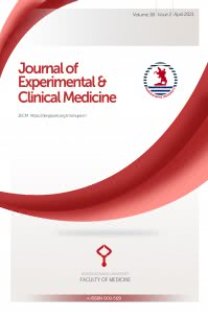Deneysel korozif özefagus yanığında lipid peroksidasyon, glutatyon ve total tiol düzeyleri
Yanıklar, kimyasal, Özofagus, Sıçanlar, Glutatyon, Lipid peroksidasyonu, Enflamasyon, Sülfidril bileşikleri, Modeller, hayvan
The lipid peroxidation, glutathione and total thiol levels in experimental caustic esophageal burn
Burns, Chemical, Esophagus, Rats, Glutathione, Lipid Peroxidation, Inflammation, Sulfhydryl Compounds, Models, Animal,
___
1. Sokol RJ. Hoffenberg EJ. Antioksidants in pediatric gastrointestinal disease. Pediatric Gastroenterolog II. 1996: 43: 2; 471-489.2. Sipahi T, Arcasoy A. Serbest radikaller ve klinik hastalıklarla İlişkisi. MN Klinik Bilimler 1996: 2: 124-132.
3. Gehanno P. Guedon C. Inhibition of experimental Iye stricture by penicillamine. Arch Otolaryngol 1981;107:145-147.
4. Wasowicz W, Neve J, Peretz A. Optimized steps in fluorometric determination of thiobarbituric acid-reactive substances in serum: Importance of exiraction pH and influence of sample preservatîon and storage. Clin. Chem.. 1993: 39(12): 2522-2526.
5. Hu ML. Dillard CJ. Tappel AL. In vivo effects of aurothioglucose and sodium thioglucose on rat tissue sulfhydryl reactivity. Agent and Actions. 1988; 25: 1-2; 132-137.
6. Sedlak J, Lindsay RH. Estimation of total protein-bound, and non-protein sulfhydryl groups in tissue with Ellman's reagent. Anal. Biochem., 1968: 25: 192-205.
7. Lowry OH, Rosebrough NJ. Farr AL. et al. Protein measurement with the folin phenol reagent. Biol. Chem., 1951; 193: 265-275.
8. Adam JS. Birck HG. Pediatric caustic ingestion. Ann. Otol. Rhinol. Laryngol.. 1982; 91: 656-65S.
9. Di Mascio P. Murphy ME. Sies H. Antioksidant. defense systems: The role of carotenoids, tocopherols and tiols. American Journal of Clinical Nutrition. 1991: 53(1 suppl): 194S-200S.
- ISSN: 1300-2996
- Yayın Aralığı: Yılda 4 Sayı
- Başlangıç: 2018
Binnur SARIHASAN, Sibel BARIŞ, Deniz KARAKAYA, Ayla TÜR, Fuat GÜLDOĞUŞ, Birol GÜLMAN
Deneysel korozif özefagus yanığında lipid peroksidasyon, glutatyon ve total tiol düzeyleri
RAMAZAN AMANVERMEZ, Faruk KAZANCI, Cemil ÇELİK, Muhlise ALVUR, Müşerref BOSTANCI
Bronkojenik kist: Olgu bildirimi
Ömer ETLİK, Kürşat UZUN, Mehmet GENCER, Osman TEMİZÖZ, Mehmet Emin SAKARYA
Göknur TARIM, Tayyar CANTÜRK, Nilgün ŞENTÜRK, Ahmet Y. TURANLI
Zafirlukast'ın hiperplastik rino-sinüzite etkisi
M. Levent ERKAN, Serhat FINDIK, Oğuz UZUN, Atilla G. ATICI, Hüseyin AKAN
Karadeniz Teknik Üniversitesi Tıp Fakültesinden mezun olacak öğrencilerin gelecek kaygıları
Gamze ÇAN, Mehmet KAPUCU, Hakan TÜRK
NURTEN KARA, Hasan BAĞCI, Recep SANCAK
İntrahepatik kolestaz ile seyreden büyük hücreli-immünoblastik lenfoma vakası
İdris YÜCEL, Cem ŞAHAN, Ertuğrul GÜNER, Tanja ÜÇER, Melda DİLEK, Levent YILDIZ
